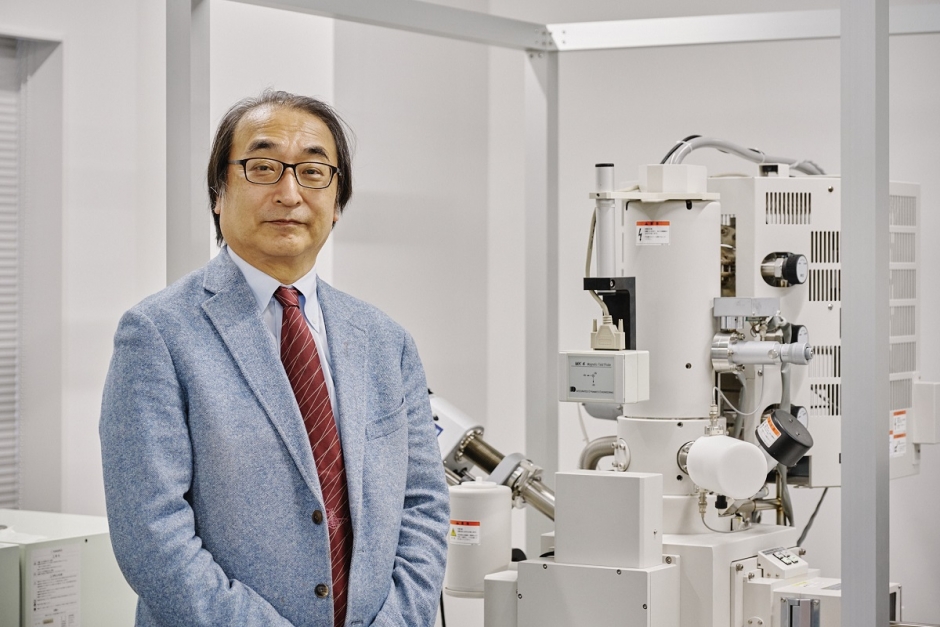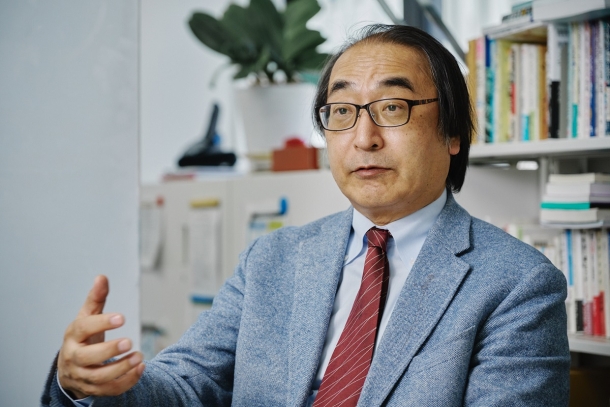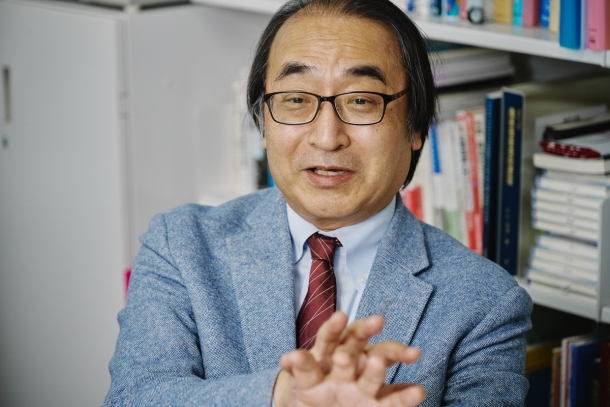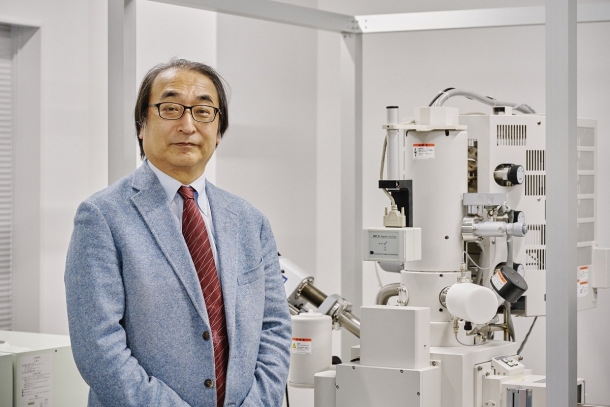- その他
- ゼオライトでカーボンニュートラルに貢献 / Contributing to Carbon Neutrality with Zeolite【先進理工学部 応用化学科・松方正彦教授】
ゼオライトでカーボンニュートラルに貢献 / Contributing to Carbon Neutrality with Zeolite【先進理工学部 応用化学科・松方正彦教授】

- Posted
- 2023年3月24日(金)

研究室全体をカーボンニュートラルに
松方正彦教授(先進理工学部応用化学科)の研究室は、代々、石油の変換技術を研究してきた研究室だ。石油から燃料や都市ガスを作ることにはじまり、石油を利用した化学品を作る技術や、そのための触媒技術を研究してきた。公害問題が騒がれた時代には環境触媒を、また石油ショックの頃には、石油以外のものから化学品を作る研究などもしてきた。そんな研究室が現在、研究室を挙げて「カーボンニュートラル」に取り組んでいる。
2020年、菅首相(当時)が国として2050年までにカーボンニュートラルを目指すことを宣言した。これは、それまでの日本の温室効果ガス削減目標を大幅に引き上げ、また時期も前倒しするものであった。これについて、松方教授は次のように話す。
「それまでの目標であった80%削減は、逆に言えば20%はCO₂を出してもいいということです。でもカーボンニュートラルだと、これが0になる。“20%出してもいい”と“0”はまったく意味が違います。2050年のカーボンニュートラル化に貢献する技術開発をしようと、現在、研究室の研究テーマをすべてカーボンニュートラルに集約しようと考えています」(松方教授)

CO₂から“未来の原料”を作り出す
研究の中心にあるのは「ゼオライト」という物質だ。ゼオライトはケイ素、アルミニウム、酸素、ナトリウムなど、地球上に豊富に存在する元素からできており、結晶構造の中に小さなミクロ細孔があいているのが特徴。ミクロ細孔は分子を取り込むことができ、そこに入るものと入らないものを分けたり、その中で化学反応を起こしたりすることができるため、触媒や分離膜として利用することができる。このゼオライトで目指すのは、“未来の原料”を作ることだ。松方教授がこう説明する。
「カーボンニュートラルの世界でも、化学品を使い続けるには炭素が必要です。しかし、化石資源を使わないとするとカーボンソースの選択肢は3つしかありません。バイオマス、二酸化炭素(CO₂)、そして廃プラスチックを含む廃棄された化学品です。カーボンソースを何にするのか、どのように実用化するのか。原料転換が必要なのです」(松方教授)
例えばCO₂では、工業プロセスや大気中からCO₂を分離する技術や、分離回収したCO₂を化学原料や燃料に転換する触媒プロセスの技術が必要となる。ここで、これまで研究室で積み上げてきた触媒や分離膜の技術が活きてくる。また、CO₂を還元して炭化水素にすると水が発生するため、反応系から水を取り除かなければならないが、ここでもゼオライト膜が活躍する。
「ゼオライト膜は、もともと半導体ウェハーの洗浄工程で利用されていました。ウェハーの洗浄には水と溶剤が使われますが、洗浄後の洗浄液から水を取り除き、溶剤だけを回収するのです。現在は、バイオエタノールを脱水して燃料グレードのエタノールを製造する技術としても利用されています。どんな技術でも水を取り除くことが大事ですが、そのためには触媒と膜の技術が欠かせません。幸い、我々はその両方をやってきたので、その経験が役立つと思っています」(松方教授)

発想はバックキャストで
同じ化学原料を作るなら、できるだけ消費するエネルギーは少ない方がいい。そのためCO₂を化学原料にすることなど、少し前なら考えられなかった。しかし温室効果ガスの削減が求められると、再生可能エネルギーから作られた水素がエネルギーとして使われるようになり、どんなにコストが安くても化石燃料の使用には制限がかかるようになった。それがグローバルなトレンドとなり、あるいは政府の目標にもなったことで、初めて現実味が出てきたのだ。
2050年に向けて研究を続ける松方教授が大事にしている考え方がある。それは、「今できること」「自分がやってきたこと」など、今からの「フォアキャスト」で考えるのではなく、2050年にどういう社会を作りたいかという「バックキャスト」から発想することだ。
「5年くらい前、研究仲間が「空飛ぶタクシー」について議論しようとある場で提案したところ、一笑に付されたそうです。「今できること」から考えることが、いかに考えを狭め、新しい技術に対する判断を鈍らせるかという典型だと思います」(松方教授)
現在、松方教授の研究室では約20名の学生が研究者としての経験を積んでいる。「人を育てるのは、大学の研究室の大きな役割です」と話す松方教授。世界の目標となった2050年のカーボンニュートラルに向け、ゼオライトをフル活用して研究に邁進。技術開発と人材育成の両面から、社会に貢献していく。
プロフィール
松方正彦 教授(先進理工学部 応用化学科)
まつかた・まさひこ/1960年生まれ。1984年早稲田大学理工学部応用化学科卒、89年同大学院博士後期課程修了。工学博士。1989年成蹊大学工学部助手、1992年大阪大学基礎工学部助手、1997年早稲田大学理工学部助教授などを経て、2001年から現職。1995年化学工学会奨励賞、96年石油学会奨励賞、99年触媒学会奨励賞、2019年度早稲田大学リサーチアワードを受賞。専門は分離工学、触媒化学。
所属学会
化学工学会、日本膜学会、米国化学工学会、日本化学会、米国化学会、石油学会、日本吸着学会、日本ゼオライト学会、日本工学アカデミー、日本工学会。
Devoting the Entire Laboratory to Carbon Neutrality
In the laboratory of Professor Masahiko Matsukata (Department of Applied Chemistry, School of Advanced Science and Engineering), research on petroleum conversion technology has been conducted for years. Since the start of the production of fuel and town gas from petroleum, he has been conducting research on technologies for producing chemicals from petroleum as well as research on catalytic technologies used in those processes. In this laboratory, research on environmental catalysts at the time when pollution was a hot topic issue, and research on the production of chemicals from materials other than petroleum during the oil crisis. Professor Matsukata is currently working toward “carbon neutrality” by devoting all efforts of his laboratory.
In 2020, then Prime Minister Suga declared that our country will achieve carbon neutrality by 2050. This drastically raised the goal of greenhouse gas emission reduction in Japan and brought the schedule to the foreground. Some of Professor Matsukata’s comments on this are as follows.
“Until then, the reduction target was 80%. This implied that we could still generate CO₂ by 20%. However, carbon neutral means that this number should be zero. “You can generate 20%” and “0” have completely different meanings. In order to develop technologies that contribute to achieving carbon neutrality by 2050, we are currently planning to concentrate all of our research themes to carbon neutrality.” (Professor Matsukata)
Creating “future raw materials” from CO₂
At the center of this research is a substance called zeolite. Zeolite is made of elements that exist in abundance on Earth, such as silicon, aluminum, oxygen, and sodium. These materials are characterized by small micropores in their crystal structures. Micropores are capable of capturing and separating molecules that fit into the pores from molecules that cannot. Also, chemical reactions can occur inside the pores. So, they can be used as catalysts or separation membranes. He is aiming to use zeolite to create “future raw materials.” Professor Matsukata’s explanation is as follows.
“In order to keep using chemicals, carbon is needed even in a carbon neutral world. However, if we can’t use fossil fuels, there are only three options for carbon sources. Biomass, carbon dioxide (CO₂), and discarded chemicals including waste plastics. Which should we use for a carbon source and how should we put it to practical use? The answer is, we need changes of raw materials.” (Professor Matsukata)
For example, technologies used for separating CO₂ from industrial processes or the atmosphere, as well as converting the separated and recovered CO₂ into chemical raw materials or fuel, require the use of catalytic processes. This is where the technologies of catalysts and separation membranes can be utilized that have been accumulated in the laboratory until now. In addition, when CO₂ is reduced to hydrocarbons, water is generated and must be removed from the reaction systems. Zeolite can be also used there.
“Zeolite membranes were originally used in the cleaning process of semiconductor wafers. Water and solvents are used to clean the wafer, but after the cleaning, water must be removed from the cleaning solution to recover the necessary solvents. Currently, this technology is also being used to produce fuel-grade ethanol by dehydrating bioethanol. Removing water is important in any kind of technology, which means catalysts and membrane technologies are indispensable. Fortunately, we have been developing both technologies, so I think the experience will be helpful.” (Professor Matsukata)
Innovation by backcasting
If you are to make a raw chemical material, it is best to consume as little energy as possible. Until recently, we could not imagine using CO₂ as a raw chemical material. However, when greenhouse gases need to be reduced, the hydrogen produced from renewable energy is used as energy. The use of fossil fuels is restricted no matter how low their costs are. This idea became a global trend, and even a government goal. After that, it became realistic for the first time.
Professor Matsukata, who continues his research with 2050 in mind, a very important way of thinking. He believes that we should not think things by “forecasting” the future, such as thinking by “what we can do now” or “what we have been doing.” Rather, we should think by “backcasting” from what kind of society we want to create in 2050.
“About five years ago, a fellow researcher proposed a discussion about a “flying taxi,” but everyone there laughed it off. I think it is a typical example that shows how it narrows our thoughts or misleads our judgment on new technologies if you are thinking about “what we can do now.” (Professor Matsukata)
Currently, about 20 students in Professor Matsukata’s laboratory are gaining experience as researchers. “Developing human resource is an important role of a laboratory in a university,” says Professor Matsukata. To achieve the global goal of carbon neutrality by 2050, he is pushing forward with his research by making full use of zeolite. He will contribute to society through both technological development and human resource development.
Profile
Professor Masahiko Matsukata (Department of Applied Chemistry, School of Advanced Science and Engineering)
Born in 1960. He graduated from the Department of Applied Chemistry, Faculty of Science and Engineering, Waseda University in 1984 and completed the Graduate School of Science and Engineering, Doctoral Program in 1989. Doctor of Engineering He served as an Assistant Professor of the Faculty of Engineering at Seikei University in 1989, an Associate Professor of the Faculty of Engineering Science at Osaka University in 1992, an Associate Professor of the Department of Applied Chemistry, Faculty of Science and Engineering at Waseda University in 1997, and as Professor of the same department in 2001. He was awarded the Society of Chemical Engineers Encouragement Award in 1995, the Japan Petroleum Institute Encouragement Award in 1996, the Catalysis Society of Japan Encouragement Award in 1999, and the Waseda Research Award in 2019. He specializes in separation engineering and catalytic chemistry.
Academic affiliations
The Society of Chemical Engineers, Japan, the Membrane Society of Japan, the American Institute of Chemical Engineers, The Chemical Society of Japan, American Chemical Society, The Japan Petroleum Institute, the Japan Society of Adsorption, the Japan Zeolite Association, The Engineering Academy of Japan, and The Japan Federation of Engineering Societies.
- Tags
- 研究活動
